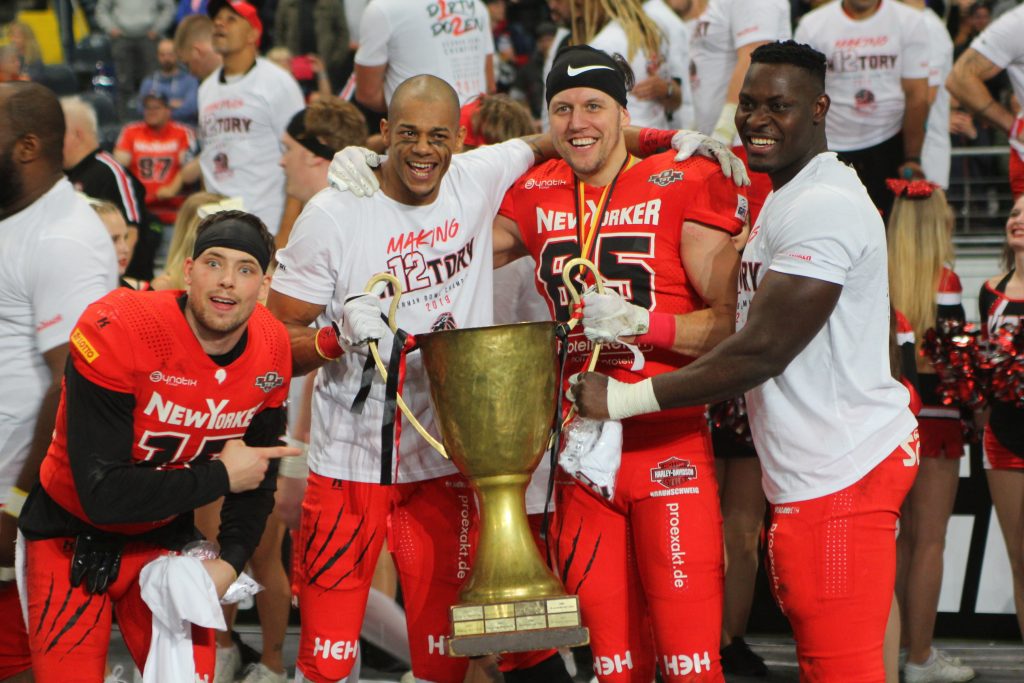
German Bowl, the German national championship game, is Europe’s American Football event with the most longstanding tradition. Inaugurated in 1979 it was the first national championship game in any of the European nations and has been played annually since then (due to the Corona pandemic with the exception of 2020).
German Bowl is played in Frankfurt/Main’s Deutsche Bank Park, a FIFA World Cup 2006 venue, which features a retractable roof and a capacity of approx. 50,000 seats. In 2019 attendance for German Bowl XLI was 20,382 and set a new record for German Bowls without a team from the hosting region competing. The all-time attendance high for German Bowls is 30,400.
Information on tickets for German Bowl is available here, tickets are on sale via ticketmaster.de. All tickets include public transportation to and from the venue on gameday. Frankfurt’s airport and main railway station are major European hubs for air and rail travel and connect the city – mostly via direct services – to nearly all major cities and regions in Germany, Europe and the world. Airport and railway station are just one or two stops away from the regional S-Bahn train station at the stadium. Also two of Germany’s major highways, Autobahn A3 and A5 intersect less than a mile away from the arena.
Care for an extra special experience? Exclusive hospitality packages are also available via this special ticketmaster subpage and include seating in the arena’s comfortable extra-large business seats, preferred parking in the stadium’s basement, a dinner-buffet before the game and during halftime and of course a selection of beer, wine and soft drinks before, during and after the game. For those who prefer the mid-field view and the comfortable seating in the VIP section, but only care for an occasional snack or drink during the event and do not need the full package, there is a ticket category 1+ (also available here via Ticketmaster): It features seating in the VIP section and use of the facilities in the business area, food and drinks are charged per serving.
The road to Frankfurt is open for everybody from the world. The sportive road to the championship is open to up to 16 clubs, eight each in the North and South division of the Erima German Football League. Four teams from each division reach the postseason, quarterfinals and semifinals are played the two last weekends of September. German Bowl is played each year on the second Saturday of October. Kickoff for the game is set for 6 p.m. CET, a stadium pre-game show starts at 4:45 p.m.
The spacious grounds around the stadium usually are packed with American football fans from all across of Europe, as a complete German Bowl day starts much earlier. FANZONE festivities begin at 2 p.m. and feature food and drink, live bands and sports VIP’s on the main stage as well as a variety of activities for young and old. As German Bowl each year has been the most attended non-NFL American Football game in Europe by far, it has been established as a fixture in the calendar not only for every American football fan in Germany, but simply for all who love to share the excitement and the fun involved, when the two top-teams from Germany compete for the trophy.
Up to now eleven different teams have conquered German national championships. Braunschweig won a record number of twelve titles, Düsseldorf and Berlin have won six each. However the Schwäbisch Hall Unicorns recently have been the toughest challenger for Braunschweig’s New Yorker Lions. The team played in eight of nine German Bowls between 2011 and 2019, winning four championships.
2 German Bowls went into overtime (1993 and 2003). 27 of the 41 German Bowls up to now have been decided by a margin of seven points or less, including the game with the highest points total in 2012 (a 56-53 victory of Schwäbisch Hall over Kiel) and the two lowest scoring battles with 10-7 results, most recently, when Braunschweig beat Schwäbisch Hall by that narrow margin before more than 20,000 at Frankfurt’s arena.
Please note: most links in this text lead to German-language pages, most of which are still self-explanatory for most of the content